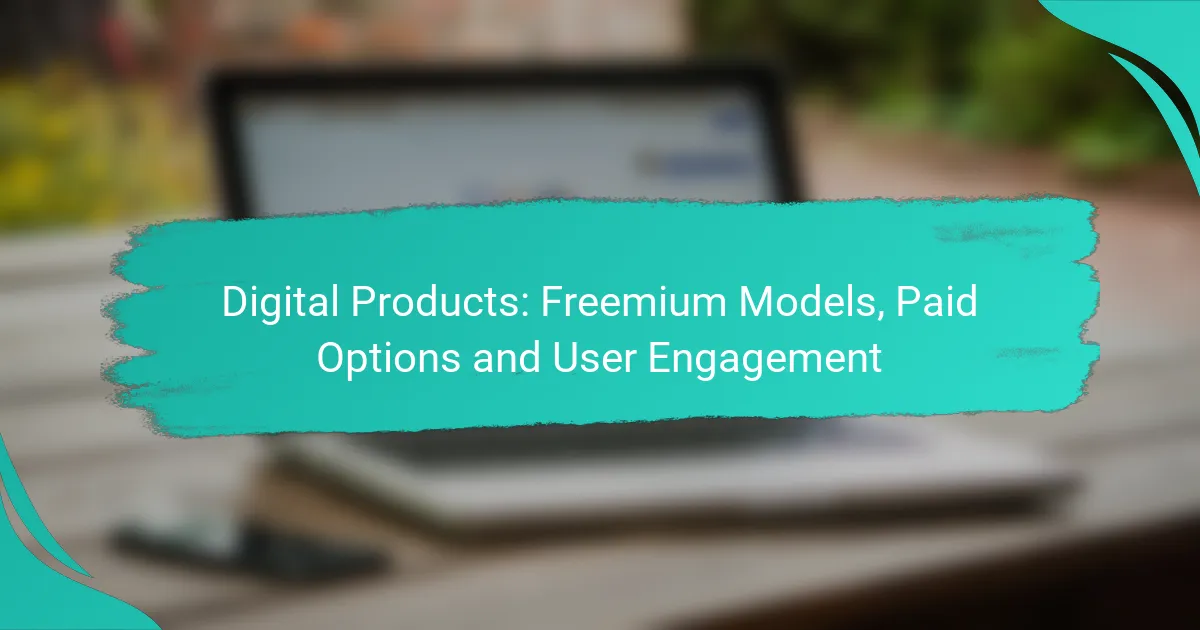Digital products often utilize freemium models, providing a basic version for free while offering premium features at a cost. This strategy not only allows users to test the product before making a financial commitment but also boosts user engagement and conversion rates. Paid options enhance this engagement by granting access to exclusive features, leading to higher satisfaction and retention. To further improve user interaction, implementing strategies like gamification and personalized experiences is essential.

What are the best freemium models for digital products in Canada?
The best freemium models for digital products in Canada typically offer a basic version for free while charging for premium features. This approach allows users to experience the product before committing financially, enhancing user engagement and conversion rates.
Spotify’s ad-supported tier
Spotify’s ad-supported tier provides users with free access to its music streaming service, supported by advertisements. This model encourages users to explore the platform without any financial commitment, while ads generate revenue for Spotify.
Users can listen to music with some limitations, such as shuffle play and occasional ads. Upgrading to a premium subscription removes ads and offers additional features like offline listening and higher audio quality, appealing to dedicated users.
Canva’s free design tools
Canva offers a robust set of free design tools, allowing users to create graphics, presentations, and social media posts without any cost. The freemium model includes access to a wide range of templates and design elements, making it accessible for casual users and small businesses.
For advanced features, such as premium templates, brand kits, and additional storage, users can opt for a paid subscription. This tiered approach helps Canva convert free users into paying customers as they grow their design needs.
Dropbox’s storage options
Dropbox provides a freemium model with a basic free storage plan, allowing users to store and share files online. The free tier typically offers a limited amount of storage, which is suitable for personal use or small projects.
As users require more space or advanced features like file recovery and enhanced collaboration tools, they can upgrade to various paid plans. This model effectively encourages users to start with the free option and transition to paid plans as their storage needs increase.

How do paid options enhance user engagement?
Paid options significantly enhance user engagement by providing access to exclusive features and improved functionality. These premium offerings often lead to higher satisfaction and retention rates, as users feel they are receiving added value for their investment.
Premium features in Adobe Creative Cloud
Adobe Creative Cloud offers a range of premium features that cater to creative professionals. Users gain access to advanced tools like Adobe Sensei, which uses AI to streamline workflows, and enhanced collaboration features that allow for real-time editing and feedback.
Additionally, subscribers benefit from regular updates and new features, ensuring they stay current with industry standards. For example, the ability to use cloud storage for easy access and sharing of projects can significantly improve productivity.
Subscription benefits of Microsoft 365
Microsoft 365 subscriptions provide users with a suite of applications that enhance productivity and collaboration. Key benefits include access to the latest versions of Word, Excel, and PowerPoint, along with cloud storage through OneDrive, enabling seamless file sharing and collaboration.
Moreover, subscribers receive regular security updates and features that protect sensitive information, which is crucial for businesses. The subscription model also allows users to choose from various plans, catering to individual needs or team requirements, making it flexible and cost-effective.

What strategies improve user engagement for digital products?
To enhance user engagement for digital products, strategies such as gamification and personalized experiences are crucial. These methods not only attract users but also encourage them to interact more frequently and meaningfully with the product.
Gamification techniques
Gamification involves incorporating game-like elements into non-game contexts to boost user engagement. Techniques such as points, badges, leaderboards, and challenges can motivate users to participate more actively. For instance, a fitness app might reward users with points for completing workouts, which can be exchanged for discounts or exclusive content.
Consider the balance between challenge and skill; if tasks are too easy, users may lose interest, while overly difficult tasks can lead to frustration. A well-designed gamification strategy keeps users motivated by providing achievable goals and regular feedback.
Personalized user experiences
Creating personalized user experiences involves tailoring content and interactions based on individual user preferences and behaviors. This can include customized recommendations, targeted notifications, and adaptive interfaces that respond to user actions. For example, an e-commerce platform might suggest products based on previous purchases or browsing history.
To implement personalization effectively, utilize data analytics to understand user behavior and preferences. However, be cautious about privacy concerns; ensure compliance with regulations like GDPR when collecting and using personal data. A good practice is to offer users control over their data and how it is used, enhancing trust and engagement.

What are the key differences between freemium and paid models?
Freemium models offer basic services for free while charging for premium features, whereas paid models require users to pay upfront for access to all features. The choice between these models significantly impacts user engagement, revenue generation, and customer acquisition strategies.
Cost structure analysis
In a freemium model, the cost structure typically involves lower upfront expenses since users can access basic features without payment. However, the challenge lies in converting free users to paying customers, which can require significant marketing and support resources.
Conversely, paid models generate immediate revenue but may limit the initial user base due to the upfront cost. This model often leads to higher customer lifetime value, as users who pay are usually more committed and engaged with the product.
User acquisition strategies
Freemium models often leverage low barriers to entry to attract a large user base quickly. Strategies may include offering free trials, referral bonuses, or limited-time promotions to encourage sign-ups. The goal is to build a substantial user base that can later be converted to paid subscribers.
In contrast, paid models typically focus on targeted marketing efforts to attract users who are willing to invest upfront. This may involve showcasing the product’s value through demos, testimonials, or free trials of premium features to entice potential customers.

How do Canadian users respond to freemium versus paid models?
Canadian users generally show a strong preference for freemium models, as they allow for initial engagement without financial commitment. However, many are willing to pay for premium features once they see value in the product.
Market research insights
Recent studies indicate that a significant portion of Canadian users are attracted to freemium offerings, with many opting to explore these options before considering a paid subscription. Research shows that around 60-70% of users engage with free versions, with a notable percentage converting to paid plans after experiencing the product’s benefits.
Freemium models can effectively lower the barrier to entry, allowing users to test functionality and usability. This approach helps companies gather valuable data on user behavior, which can inform future product enhancements and marketing strategies.
User preference trends
In Canada, user preferences are shifting towards more personalized experiences, which often come with paid options. While freemium models attract initial interest, users increasingly seek advanced features and ad-free experiences, leading to a gradual rise in paid subscriptions.
Additionally, Canadian users tend to value transparency in pricing and the quality of customer support. Companies that clearly communicate the benefits of their paid offerings and provide excellent service are more likely to convert freemium users into paying customers.

What are the prerequisites for implementing a freemium model?
To successfully implement a freemium model, businesses need a clear understanding of their target market, robust technical infrastructure, and a strategy for user engagement. These prerequisites ensure that the model can attract users while also converting a portion into paying customers.
Market analysis requirements
Conducting thorough market analysis is crucial for a freemium model. This involves identifying your target audience, understanding their needs, and evaluating competitors’ offerings. Tools like surveys, focus groups, and competitive analysis can provide insights into user preferences and pricing strategies.
Additionally, segmenting the market can help tailor the freemium features to different user groups. For instance, a software company might offer basic functionalities for free while charging for advanced features that appeal to professional users. This segmentation can enhance user engagement and conversion rates.
Technical infrastructure needs
A strong technical infrastructure is essential for supporting a freemium model. This includes scalable servers, a user-friendly interface, and secure payment processing systems. Companies should ensure that their platform can handle varying user loads, especially during promotional periods.
Moreover, integrating analytics tools is vital for tracking user behavior and engagement. This data can inform decisions about which features to offer for free and which to monetize. Regular updates and maintenance are also necessary to keep the platform running smoothly and to enhance user experience.

What metrics should be tracked for user engagement?
To effectively measure user engagement, focus on key metrics that reflect how users interact with your digital products. Important metrics include active user rates, session duration, and user retention, which provide insights into user behavior and satisfaction.
Active user rates
Active user rates indicate the number of unique users engaging with your product over a specific period, typically measured daily or monthly. This metric helps assess the overall health of your user base and the effectiveness of your engagement strategies.
To calculate active user rates, divide the number of unique users by the total number of users within the chosen timeframe. A common benchmark is to aim for at least 20-30% of registered users to be active monthly, but this can vary significantly by industry.
Monitoring trends in active user rates can reveal patterns in user engagement. If you notice a decline, consider investigating potential causes such as usability issues or lack of new content. Regularly reviewing this metric can guide your efforts to enhance user retention and satisfaction.
